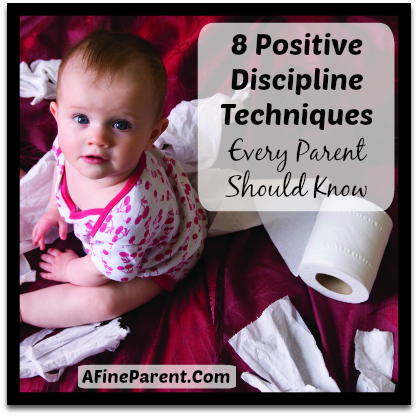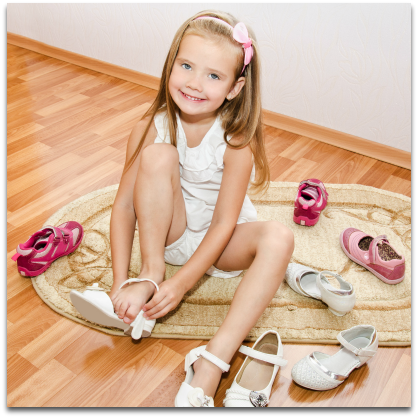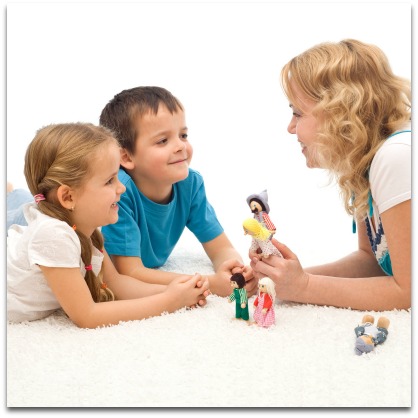 Don’t you sometimes wish you had a remote control to stop your child’s behavior with the click of a button before things start to spiral out of control?
Don’t you sometimes wish you had a remote control to stop your child’s behavior with the click of a button before things start to spiral out of control?
I remember thumbing through the Parents Magazine a while back and reading about a kid who told his pesky little sister — “I wish you were a toy that required batteries so I can take them out.“
I sometimes wish my kids had removable batteries in them too!
Then again, forget about a remote control or batteries… I’ll settle for a simple pause, just one tiny moment, to collect my wits and figure out the best way to deal with a situation without blowing my top off.
Sigh!
Since none of these fantasies have a chance of coming true any time soon, I’d like to propose a modification to a strategy Sumitha suggested some time back to keep ourselves from yelling at kids even when we are hopping mad –
Assuming you are not angry at the moment, now is the time to decide how you will respond at a later time when you are indeed angry. Making a list of possible responses and then reaching out to your pre-committed choices when you are angry, substantially increases your chances of success [at not yelling at kids]. There is a whole body of research to support this.
Here’s my suggestion. Let’s make a list of all the positive discipline techniques that we know of, and spend a few minutes looking at some example scenarios where they work well. This way, when the time comes for us to react (and sooner or later, it will), hopefully we’ll come up with an appropriate gentle response without having to think too hard. Or blowing our fuse. Sort of. Maybe.
Anyway, I’ll start out with 8 of the positive discipline techniques that I’m familiar with. How about you help grow this list by sharing your favorite techniques in the comments?
#1 Offer Choices
 When you give your kids choices instead of commands where they can use a ‘no’ response, you are less likely to end up in the typical power struggle situation. This tends to avoid no for an answer as well as complete defiance. The choice empowers the kids.
When you give your kids choices instead of commands where they can use a ‘no’ response, you are less likely to end up in the typical power struggle situation. This tends to avoid no for an answer as well as complete defiance. The choice empowers the kids.
Of course, make sure that you are okay with both choices. Do not give your kids a choice you cannot abide by, since this will only make you unreliable in their eyes.
The choices don’t have to be too complicated — just asking them how they want to do something can be quite effective. Instead of commanding “Move it, we’re getting late” a gentle “Do you want to wear your shoes first or the jacket?” will get them moving with a lot less fuss.
I’ll never forget my experience working in the classroom of a very experienced preschool teacher. One child refused to cooperate at circle time. He ignored the teacher’s directions, disciplining, and did his own little thing. One day, a few weeks into the year, the teacher decided to try a “newfangled” idea of choices. She called over little Mr. Independent and gave him a choice of seats to sit at circle time. He proudly picked his seat, and cooperated beautifully for the rest of the year. The look of shock on the teachers face was priceless. “I guess everyone can learn something new,” she muttered.
The nice thing about this most-often recommended positive discipline technique is that you foster independence, yet still hold the reins. Children love the autonomy, and you’ll love that it works — win-win!
As the authors Faber and Mazlish explain in How to Talk So Kids Will Listen & Listen So Kids Will Talk
It might seem inconsequential to ask a child whether he wants a half glass of milk or a whole, his toast light or dark; but to the child each small choice represents one more opportunity to exert some control over his own life. There is so much a child must do that it’s not hard to understand why he becomes resentful and balky.
“You must take your medicine.”
“Stop drumming on the table.”
“Go to bed now.”
If we can offer him a choice about how something is to be done, very often that choice is enough to reduce his resentment.
#2 Create a YES Environment
Children are born with a healthy curiosity, and they need the freedom to safely explore their surroundings to discover what their world is all about. It’s important not to inhibit this natural curiosity by constantly reprimanding your child for touching things around the house.
As kids get older their natural instinct is to express their individuality and push limits. At this stage it becomes essential that you give them the freedom they seek, but within well-defined limits.
With younger kids, childproofing — ex. placing all dangerous or breakable items out of reach — reduces stress for both parents and children. Your child won’t have to hear “no” all the time, and you will have more peace of mind knowing that he’s not getting into things he shouldn’t.
 With older kids, providing clarity in what is and isn’t acceptable is key. For example – “YES, you can start driving. We’ll have to agree on a driving agreement first however, and each time you violate it, you lose the driving privilege for a full month” is much more likely to motivate your teen to drive safely than trying to keep him from driving (in which case they may be tempted to “borrow” their friends car and drive it without insurance!) or constant lecturing/haranguing.
With older kids, providing clarity in what is and isn’t acceptable is key. For example – “YES, you can start driving. We’ll have to agree on a driving agreement first however, and each time you violate it, you lose the driving privilege for a full month” is much more likely to motivate your teen to drive safely than trying to keep him from driving (in which case they may be tempted to “borrow” their friends car and drive it without insurance!) or constant lecturing/haranguing.
If you use the word “no” sparingly, your kids will be more likely to pay attention when you do say it. So, whenever possible make a conscious effort to use positive wording to stop challenging behavior.
In my own case, my daughter, like most toddlers, would wreck the kitchen as I cooked supper. She would unpack cabinets, crash pots, and then whine for me to pick her up. First, I locked two cabinets with breakables and electronics so I don’t have to worry for her safety. I created a special toy cabinet, and got her a set of toy metal pots, so she wouldn’t dent mine. I also added metal spoons from the 99 cents store. Additionally, I give her my containers as I’m cooking-cheese, egg and cereal carton or whatever other recyclable I have goes on the floor. Now, I can actually cook supper calmly!
#3 Teach Emotions
 It’s never too early to start teaching your kids to express their emotions. Not being able to comprehend what’s going on is a very common reason for kids acting out. As Dr. Dan Siegel, an eminent neuropsychiatrist, and New York Times bestselling author explains in this wonderful video, they need to be able to name it, so they can tame it!
It’s never too early to start teaching your kids to express their emotions. Not being able to comprehend what’s going on is a very common reason for kids acting out. As Dr. Dan Siegel, an eminent neuropsychiatrist, and New York Times bestselling author explains in this wonderful video, they need to be able to name it, so they can tame it!
For younger children, a simple emotions chart can be great. You can even create your own by taking pictures of your child’s emotion faces.
For older children, teach them words from this feeling vocabulary list to enrich their emotions vocabulary, so they can appropriately express themselves.
In the book Flip It, Rachel Wagner Sperry states “Feelings are the root of all behavior.” And later on, “Children must become aware of what they feel, before we ask them to control it.”
I remember reading about a young mom who taught her three year old to communicate his emotions and was happy to see that it really helped. He told his mom, “When the bus brought me home today, and nobody waited outside for me, I was very scared.” Isn’t that better than a child stomping in looking like a storm cloud and none of you know why?
#4 Ignore Bad Behavior
You’ve got to pick and choose you battles. As a high school teacher who deals with teenagers, my mother says she often pretends not to hear or see certain behaviors. While this is not one of the positive discipline techniques to use too often, it works amazingly well for minor problems.
 When my daughter plays with something she’s not supposed to (such as mommy’s magazines), I’ll sometimes turn a blind eye. If she’s safe and happy, and I’m not concerned about the object, I’ll move the object out of reach at a later time.
When my daughter plays with something she’s not supposed to (such as mommy’s magazines), I’ll sometimes turn a blind eye. If she’s safe and happy, and I’m not concerned about the object, I’ll move the object out of reach at a later time.
Here’s the thing — we’re not a policeman and acting like one can be draining. So, let’s give ourselves and our kids a break. Kids will be kids, and honestly, don’t we also need some breathing time? As long as we use this judiciously, we can create and enjoy a more relaxed atmosphere in our homes.
Sometimes, children seek negative attention. By ignoring the bad behavior, we take away the fun of it and reduce the incentive to engage in such behavior in the future.
#5 Use Fictional Third-Party Mediators
 With little kids, use a puppet to model positive behavior, or mediate fights. A third party can help cool things down and diffuse tension. Pick a quiet time for a quick puppet show modeling positive behavior. It doesn’t have to be a fancy puppet — easy homemade spoon puppets , popsicle puppets, or paper plate puppets work just fine.
With little kids, use a puppet to model positive behavior, or mediate fights. A third party can help cool things down and diffuse tension. Pick a quiet time for a quick puppet show modeling positive behavior. It doesn’t have to be a fancy puppet — easy homemade spoon puppets , popsicle puppets, or paper plate puppets work just fine.
My friend uses supper time to model positive eating habits through a puppet. Her children love the creative shows, and as a bonus, they behave through the show and supper!
With older kids, use the news stories or current events as mediators that facilitate difficult conversations. For instance, talk to your teens about the riots in Ferguson, Missouri. It is a great way to bring up racism, diversity, rioting and other difficult topics. Discuss it by reviewing a variety of perspectives – from your family’s point of view and the values you hold dear, from a broader perspective of what this means to a community, the balance between power and responsibility etc.
No one likes to be lectured all the time. A third-party, especially a fictional character or someone on media, can get a message across a lot more effectively and with a lot less resistance.
#6 Play Detective
 Why is your child acting out? Are there times of the day or specific activities when challenging behavior is most likely to occur? Could other children or adults in close proximity be a trigger? Are there environmental conditions that may be a factor? (e.g., too warm, too cold, too crowded, too much noise, too chaotic, weather conditions). Or can any of these circumstances be a factor: illness, allergies, change in diet, medication change, hunger, parties or crowds, change in caregiver, fatigue, change in routine?
Why is your child acting out? Are there times of the day or specific activities when challenging behavior is most likely to occur? Could other children or adults in close proximity be a trigger? Are there environmental conditions that may be a factor? (e.g., too warm, too cold, too crowded, too much noise, too chaotic, weather conditions). Or can any of these circumstances be a factor: illness, allergies, change in diet, medication change, hunger, parties or crowds, change in caregiver, fatigue, change in routine?
See if you can find the source of the tantrum before jumping to conclusions. Circumstances can influence behavior, so when you examine outside issues you can avoid future outbursts.
Another good idea may be recording what time of the day the behavior occurs. You can use the ABC log (antecedent, behavior, consequence) to see if a pattern emerges.
With older children, you can include them in the process of figuring out what’s bothering them.
My big concern a while back was my toddler’s grating bedtime cry. Then I learnt to take a minute and think-why is my daughter crying? One time, I returned to her room and smelled a dirty diaper. Another time, after a full day of refusing most food, she threw up. On a different occasion, I realized she was plain hungry. I never regret double checking and thinking- What can be causing this behavior?
Behavior serves as a function. If you can figure out what causes the behavior, you can figure out how to try to stop it.
#7 Be Consistent
 Make sure you are consistent in your discipline. Your child needs to know what is and isn’t acceptable. And they judge that by what was and wasn’t okay yesterday and the day before.
Make sure you are consistent in your discipline. Your child needs to know what is and isn’t acceptable. And they judge that by what was and wasn’t okay yesterday and the day before.
If they’re not getting a consistent message, they do not know how to behave. That can leave your child feeling confused and insecure.
Try to keep to the same schedule every day. That means having regular nap times, mealtimes, and bedtimes, as well as times when your child is free to have fun.
When you do have to make a change, it helps to warn your child in advance. This can prepare her for a slightly different routine, and hopefully prevent a scene.
For a major change, such as a move, new sibling or death, a simple homemade book that the child can reread can be immensely helpful. If you are moving, put a picture of the old house, neighborhood, and new house. Write down what will occur. This will give the child an understanding of what’s occurring, and prevent myriad discipline issues.
My friend’s six year old daughter told her mother she would not attend aunt’s wedding. Baffled at her refusal, she thought about it and realized that her daughter had no clear picture of what the day would be like. She sat down with her and explained the entire wedding day. Her daughter calmed down and they happily attended the event.
Children thrive on routine. If they know what’s coming, they are less likely to act out. Hey, you also behave better if you know why your spouse had a hard day!
#8 Divert and Channel
Diversion is a great tool to use with younger children. Little ones have a short attention span and you can use this to your advantage. You may be able to distract them from whatever they are fussing about. Instead of giving in, find something new to do or talk about that might interest your child.
During the witching hour, if my daughter’s behavior starts getting to me, I try taking her to a different room, or going out for a walk. Some fresh air always seems to help.
For more great ideas, check out the list of 101 Fun Things To Do With Kids To Enjoy Everyday Family Life — it is chock full of suggestions to avoid the need for nagging and screaming by turning everyday situations into fun time!
With older kids, you may need to be more strategic about this. If you get constant complaints of your child being restless and distracting the class from his teacher, enrolling him in a sports team may help channel some of his energy.
 Consider for example the case of Michael Phelps — his elementary school teacher complained to his mom that he couldn’t focus. By 6th grade he was diagnosed with ADHD. But by helping him channel that excess energy into swimming, his mom and coach were able to help him beat the odds and rise to unprecedented heights!
Consider for example the case of Michael Phelps — his elementary school teacher complained to his mom that he couldn’t focus. By 6th grade he was diagnosed with ADHD. But by helping him channel that excess energy into swimming, his mom and coach were able to help him beat the odds and rise to unprecedented heights!
In the end, this is what it boils down to — nobody’s perfect, but we can all try to be better. It doesn’t matter that we have the perfect response to every situation. By becoming aware of more and more of these positive discipline techniques however, we can significantly improve our changes of responding appropriately. At least that’s the hope, right?
Do share what works for you in the comments below… we’re all in this together, remember?
The 2-Minute Action Plan for Fine Parents
For our quick contemplation questions today –
- What are some of the positive discipline techniques that are in your tool kit (you wrote them down in the comments below, right?) Which ones do you use often? Which ones should you be using more of?
- Did you learn of any new techniques today from this article (or the comments below)? Take a moment to think them through so they become a part of your toolkit going forward!
- Think of the last time your kids pushed your buttons. What could you have done differently? Would any of these techniques helped you handle it better? What can you do now to remind yourself to use one of these positive discipline techniques next time the same situation occurs?
The Ongoing Action Plan for Fine Parents
Remember how you were disciplined as a child.
How does that affect the way you discipline your children?
What long term changes can you plan to ensure the use of positive discipline? Think of your biggest discipline issues. Chart out a course of positive techniques-preferably prevention, and if the behavior occurs, how you will respond. And start putting it into action!
If you use old discipline techniques like spanking, shaming or name-calling that have been proven to be ineffective, try to figure out the trigger, and how you can avoid falling back to it in the future. Extra brownie points if you apologize to your child for your behavior and try some of these great relaxation exercise to help you stay calm.
Offering choices has been working for me most of the time. When it doesn’t work I usually tell her how I feel about that. She is only turning 3 but has been always very empathetic so she changes her behaviour when she realizes is making me sad.
And she tells me all the times I am making her cross.
When she is impatient, telling her all that is going to happen before what she is expecting helps to distract her and keep the tears away.
Frustration is the challenge at the moment, it breaks my heart seeing her crying because she is still not able to do something by herself. The only thing I can think of doing is comfort her while she cries for a minute to help her calm down and tell her it’s ok to be frustrated and she should try again in a few days as she’ll learn in due time.
For that tricky age of 3, helping your son Name It to Tame It, as Dr. Dan Siegel suggests, is SO important for helping him get through the tantrums. In The Whole Brain Child, with Tina Payne Bryson, Dr. Dan explains how to engage with your son’s right brain (emotions, senses) before trying to re-direct his behaviors by engaging his left brain (words, logic). This was a really helpful concept to help me deal with my very strong-willed and intense 3-5 year old daughter, whose tantrums just seemed to get bigger as she did.
What it looks like is just getting down to his eye level (you reduce your threat and become more of an ally), and say things like, “Wow, you seem really upset about leaving preschool today. I am here with you, and I will help you tell me about it. I’m just going to stay close or hug you for a minute until you can calm down…” And you give him time. You are acknowledging his feelings, and you are assuring him you are OK with big feelings. Then when he’s a little more able to respond, you can help him name what he is feeling – happy to be there, sad to leave, or maybe something he wanted to finish is still undone, whatever triggered the upset. By helping him attach words to his feelings, you are helping him engage his left brain. As you help him work with both hemispheres of the brain, (integration) you help his brain calm down. You are helping him figure out how to calm himself down, too, later on when he does have words for feelings.
Even if he’s still loud for while, parents will observe your calm response and see him respond sooner than with the kicking and screaming removal, I hope. And yes, I have SOooo been there, done that, too! Hang in there. You are building social-emotional skills that will give him tools to help himself through his own upsets in the future. It is really awesome when he does start to use words and calming techniques for himself. And as you coach him, you will get better at handling your own emotions when you have a screaming 3 year old (because it IS stressful for you.) As you name your own feelings to tame them, so you are available with your whole brain to help him find his own equilibrium.
And as a bonus, this concept is helpful for dealing with other people in your life when they are having BIG FEELINGS, too, such as spouses, bosses, co-workers. Engage with their emotions before trying to engage their logic, thinking brain, and give everyone a little space to calm down before trying to talk about it.
My niece has three children with one set of twins. The other day we were watching and singing children’s nursery songs over YouTube with one of the youngest twins when his oldest brother joined in to share in the activity. Immediately the young toddler started pushing his brother away saying “No, no, no!” in an attempt to exclude his brother from the attention and the activity. He wanted all the attention to himself. I immediately tried to explained to him that his brother only wanted to join in with the fun we were having together. That what we were doing was fun and others might want to join in and have some fun too! This worked to no avail. It was only when I pulled him close to me and gave him a gentle loving hug, kissed him on the cheek, and whispered in his ear how much I loved him and kindly asked him to please be nice to his brother did he finally stop the behavior. He needed reassurance that he was loved. Sometimes it’s not enough to share activities with your children, but you also must actively demonstrate how much you love them with warm loving hugs and kisses.
I love this little mini course ….when I wake each morning I’m excited as it’s the first thing I read while having my coffee…..I think I might be a little late in the game though as my child is almost 7 ….some of the techniques will work but some I think he’s past already….can you recommend something age appropriate for us? I have a sticky situation with my son as I adopted him and some behaviors are hard to break. For the most part he’s an amazing child but at least once a week he has a complete rage tantrum and I’ve tried several ways to address it and each time I fail 🙁
Thanx for post this helpful article. Sometimes, when tasks and schedules get overwhelming, it’s helpful to make a to-do list to make things feel more manageable and focused. If your children’s behavior problems have you feeling overwhelmed and not knowing what to do first.
If you are searching best preschool for your child then you should visit Cambridge Montessori preschool.
Cambridge Montessori Preschool is the best preschool in delhi .
Excellent post! I am currently teaching my little son everything about emotions. He is starting to distinct each emotion which means that he is one step closer to taming them. Thank you for your precious insights!
Great articles and comments everyone. I have a 3 yr old boy who is quite aggressive, loud and gets very angry. I find it hard to discipline at times because it’s like world war 3! We have moved back to Australia from the US where he was born and was all he knew, now he is home with me and since going to day care is hitting spitting and screaming a lot when asked to do something. Hoping he will settle, I’m trying very hard to be positive but I don’t know what to do when it backfires. Like going to bed is an ordeal, we have a routine he’s had it since birth then it’s one more story one more milk etc but if I say no more now good night and he starts screaming and losing it I give in. I guess I’d like to know what to do when he doesn’t want any choice or to even listen to me. If I say no or walk away the tantrum goes on very loudly for quite awhile, we are in an apartment so I’m worried about being very loud and disturbing neighbors even tho I know my child matters more but I don’t need noise complaints either. Other things are leaving day care he breaks down about leaving til I end up picking him up kicking and screaming and take him to the car with parents and everyone looking at him like something’s wrong, it’s not a good feeling and I don’t want people to think my son is terrible, he’s very smart and a sweet boy when he’s not angry or really wants something, any advice much appreciated 🙂 – Emily
Hi Emily my daughter is 3 years old and seems the exact copy of your boy , I have exact same problems too I can relate , I know this is an old post but she the same.
As a positive discipline educator I am always advising parents to provide choices (one’s they are willing to do). I always explain that in time the idea of providing choices will become second nature because it becomes more natural the more you do it. The other day I laughed as I was in Pet Smart with my two kids and they asked for a reptile. I immediately replied, “no”. In unison both of the kids looked at me and said can you provide us two choices. HA!! Clearly they too have become used to choices being offered and called me out on it when I didn’t offer a choice. I smiled and said, well we are not getting another pet. So we have two choices 1) we can stay here and look at the pets some more or 2) we can go to a park!!! Just a cute reminder of how used to the positive parenting practices my kiddos are. 🙂 Heather Pincelli
A great article, as always. Thank you!
I tried ‘Ignore Bad Behaviour’ – almost by accident – the other day, and it worked a treat. I agree with Alvin that it can be tricky, and it’s one to use carefully but it was fantastic for my 7 year old daughter’s tantrums. She’s exhausted at the end of the school year and frequently collapses into a wailing, crying heap. She’s simply overwhelmed and over tired from the school year.
Anyway, the other day it was bedtime and she couldn’t cope with it all, so she collapsed into her wailing heap. I couldn’t cope with it either, so I left the room. Dad was brushing her older sister’s teeth, so no one else was in the room. The wailing miraculously stopped after a very short time. She pulled herself together, got up, and got on with going to bed.
I’ve found this is frequently the best way to deal with tantrums and wailing from her, as it’s often done very dramatically. Obviously I’m not going to do this if she’s really hurt (physically or emotionally), nor can I just walk off if she has a melt down in public, but in the right moment it’s effective.
It’s a bit like my husband says about his power tools: the right tool can make a job so much easier. So, thanks for giving us more tools! 🙂
Thanks for the kind words, Cate.
I was thinking about this quite a bit after responding the Alvin the other day. I remember I wasn’t very comfortable with the “ignore bad behavior” advice before either. I think what shifted it for me was an additional clause to it – ignore the bad behavior, but don’t ignore the child. In our case too, when my daughter starts getting too agitated, I just step away and let her calm down a bit and generally when she does I try to give her a hug and listen. Most of the time it works (“Most of the time” being the operative key phrase :))
Love the analogy of power tools — so appropriate. Can’t wait to read the article you’re putting together for us for next month!
Such great tips, Kaila: so concrete and actionable.
One tactic I’ve tried to practice is what I call “give the benefit of the doubt.” In others words, I try to assume the child is not trying to drive me insane on purpose, but is operating out of a framework or goal that it is not immediately visible to me (especially when steam is coming out of my ears).
For example: the summer before many teenagers leave for college can just be hell on wheels. They regress by decades, act out over the most modest parental request (“Can you pass me the salt?”) and do their very best to make it perfectly clear just how stupid Mom and Dad and — oh heck, go for broke — the entire family is.
But if I give that child the benefit of the doubt (my insanity is simply a by-product, not the goal, of their behavior), I can look at the situation through their eyes. They are simply trying, no matter how poorly, to separate from us so they can be strong enough to leave. Now that college is a reality, and there’s a hard date for moving into the dorm, the whole idea begins to look downright nuts instead of exciting. They have to convince themselves they WANT to leave the nest (so warm, so safe) for all the uncertainties and demands of higher education, a tiny dorm room and life with a stranger. They have to take some pretty big steps toward really growing up in a compressed time period. With that perspective, I can be gentler in my disciplining, ignore some of the crap and be more lavish with my unconditional love during a very stressful time for THEM.
Oh and thinking of toddlers as “little scientists” helps understand why they’re constantly testing the laws of physics … and your patience.
Gosh, I LOVE both those points, Marianne!
I’m particularly bad at seeing why my daughter is behaving a certain way, especially when steam is coming out of the ears. But as you say, when I “give her the benefit of doubt” and ask her outright “I know you are not trying to drive me nuts by making a mess with your milk instead of drinking it… will you please tell me why you are doing it” she actually does!!! She is very often taken by surprise that I am so agitated over it and wouldn’t even have noticed the mess until I start getting agitated — “I was just checking if I can make music by blowing into the straw, mama. Sorry I made a mess”… and then she cleans up the mess too! Of course those are the days, when I remember to ask her, instead of just telling her to stop making such a mess and then it’s a whole other story!
As for “little scientists” – I never thought of it that way, but by golly, I wish kids would come pre-loaded with some understanding of basic physics and chemistry! During a particularly high experimentation period last year, my daughter broke her jaw and her arm in 2 separate incidents in a 2 week period. Not fun!
PS: Love the way you put your thoughts across… so excited that you’ll be putting together a whole article for us next month! Yaay 🙂
As always, great article. The only thing which I don’t agree is “#4 Ignore Bad Behavior”. Ignoring bad behavior is not positive parenting. To me, this is just avoiding to address it. For minor instances, what worked for us is we don’t have to address it right away, but we eventually address it with the kids. One behavior we wanted to address was the kids constantly put their clothes all over the floor in their rooms. We tried several things, but what eventually worked for us was the following:
– We no longer did not make a big deal out of it. They are safe, they are just kids so we expect them to make a mess.
– We added a todo list white board in their rooms. Twice a week, they are required to clean up their rooms and this includes picking up clothes on the floor.
This has worked great for us. The nagging from us and the complaints from the kids has almost stopped. We just ask the kids “What are you supposed to do today?”. If that day falls on a “Clean My Room Day”, most of the time, they do it. If for some reason, they are tired, or don’t want to clean their room, we asked them when they want to do it, have them update the todo board.
Regards,
Alvin
Thanks for the kind words about the article, Alvin.
About #4, I think you and Kaila might be saying similar things but from different perspectives? For instance, Kaila says when her kids play with her magazines, she ignores the behavior at the moment, but moves the object out of reach later. So technically, she is addressing the issue but using “prevention” as a primary tool since her kids are younger (both her girls are under 2) and difficult to really involve in addressing the issue. I see both perspectives, and I think as with all things parenting, there are no “one-size-fits-all” solutions. As Kaila herself says, “While this is not one of the positive discipline techniques to use too often, it works amazingly well for minor problems.”
By the way, I love your idea of a to-do list white board. I can see how that can help reduce a lot of the nagging and bickering… Thanks for sharing!
Another great article. Thank you! I personally like to offer choices as often as possible. I’ve been learning more and more lately how to “play detective” and I think that’s such an important and effective technique. I also want to “teach emotions” more often. I love the idea that what we’re doing now to discipline our children is going to impact them the rest of their lives. Very important work and I’m glad we have resources like you to help on this journey 🙂
Thanks so much for sharing @Vibha @Chris @Melanie. It’s so nice to get more ideas.
Thanks, @Melanie 🙂
About “I love the idea that what we’re doing now to discipline our children is going to impact them the rest of their lives.” — I think it goes way beyond that! What we do now, not only impacts the rest of our kids lives, but also how they parent some day and so the impact they have on their kids and so on! It’s that thought that helps me take a deep breath and bite my tongue when I’m too agitated and try giving positive parenting a chance… we can perpetrate the old, ineffective way of raising kids (nagging, yelling or in some cases even spanking) or we can set in motion the wheels of a much more positive way to live our lives and raise kids. It really is a choice with a little bit of work upfront, but a very long lasting impact!
Hi there! Thanks for sharing this valuable article. As a dad who struggles with not only self-discpline but also disciplining (is that a word?) my children, the above techniques are quite helpful and enlightening. My wife is a elementary educator and uses these awesome techniques regularly. She’s a champ!
So yes, these techniques work and I will try to remember a few as my family grows together.
Additionally, I’m partial to bringing in “fictional third parties”. I’m naturally a goof, so making things up on the fly is fun and useful, especially at bedtime.
I’ve noticed that a sense of competition is appealing to my oldest. There have been several occasions where I’d “race” her to finish bites of food (especially veggies and the like). I’d tempt her by saying I bet I can finish a bite faster than she can…then it’s off to the races. Of course, she almost always wins the race. So some built-in losses are necessary 😉
Again, thanks for posting. Enjoyed reading and forwarded on to my darling wife.
-Chris
@Chris, we do that too! We set up our daughter to either race against us or the clock, and most of the time it works. And yep, totally agree — a few built-in losses are just what it takes to keep that competitive spirit alive and kickin’ 🙂
This is a great article ! I loved Ignore bad behaviour and using puppets! Thank you!
Glad you liked it Vibha! A variant of the puppets idea that we used at home when my daughter was young was that of a “personal fairy” — when she behaved well, she’d get surprise visits from her personal fairy who left a book or a trinket and a personal note commending her on her good behavior. Worked beautifully until one fine day my daughter asked me if the fairy was real or I had something to do with it. Her fairy left her one last gift and a note some time after that saying she had to go out of town and would try to come back soon. We haven’t heard from her since 🙂